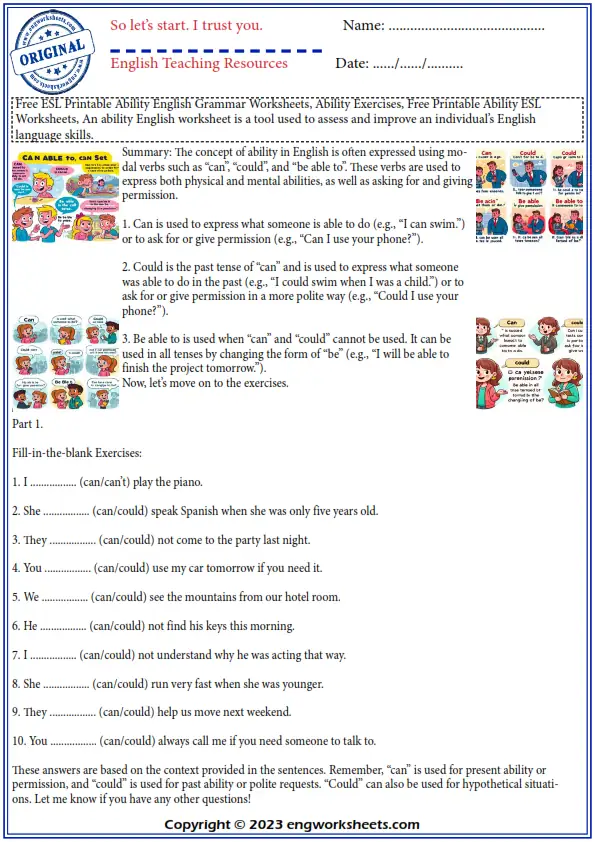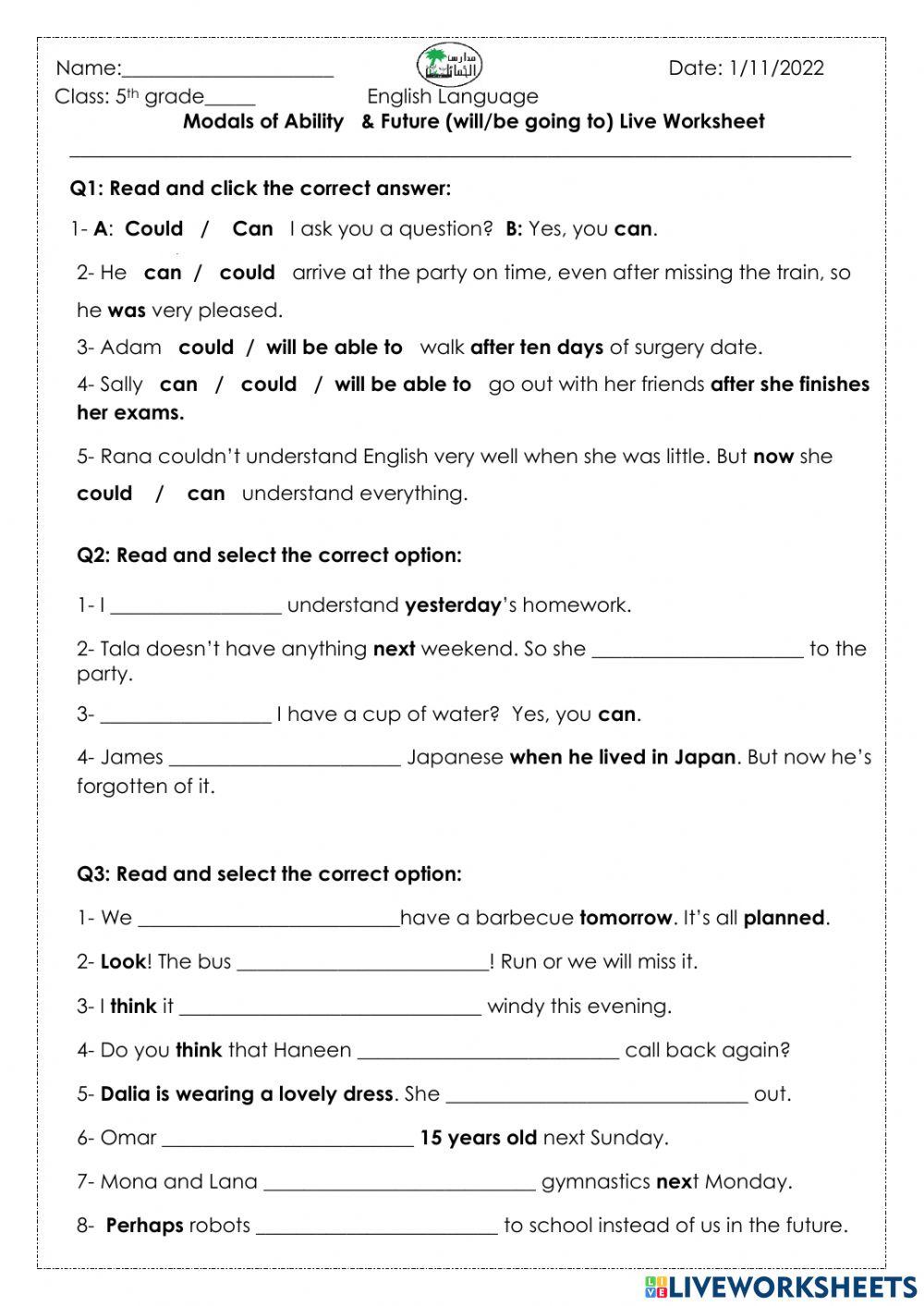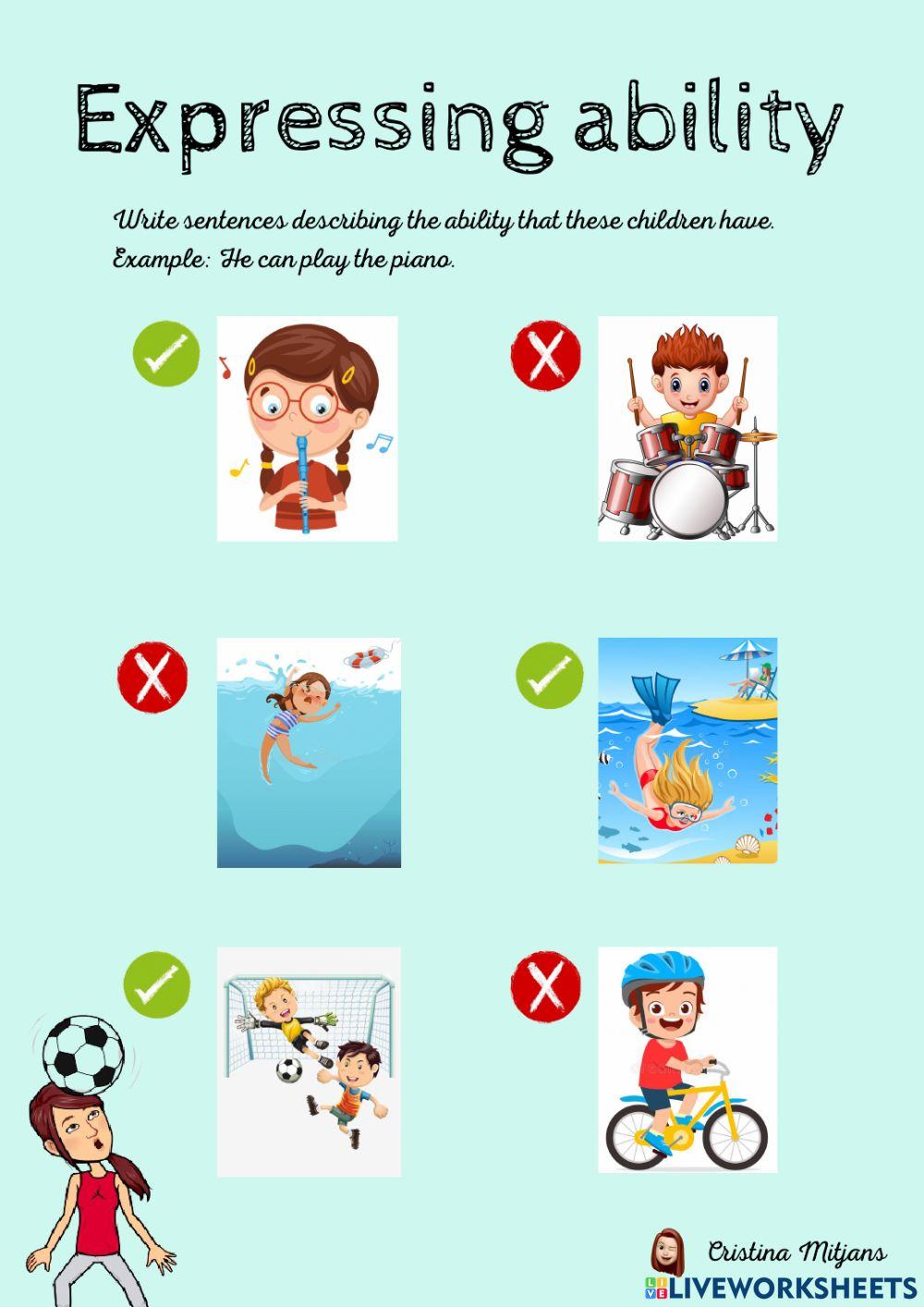
Unlocking Potential: The Transformative Power of Ability Grammar Worksheets
In the intricate tapestry of language acquisition, grammar serves as the foundational warp and weft, providing structure and clarity to our communication. Among the myriad grammatical concepts, expressing ability—the capacity to do something—is fundamental. Whether it’s discussing what one can do, what one could do in the past, or what one will be able to do in the future, mastering the nuances of ‘can,’ ‘could,’ and ‘be able to’ is paramount for fluency and accurate expression. While theoretical understanding is a crucial first step, it is through consistent, targeted practice that true mastery is achieved. This is where ability grammar worksheets emerge as an indispensable tool, offering a structured, systematic, and often highly effective pathway for learners to solidify their grasp of these vital grammatical constructions.
This article delves into the profound impact and multifaceted nature of ability grammar worksheets, exploring their pedagogical benefits, diverse formats, effective implementation strategies, and their evolving role in modern language education. We will uncover how these seemingly simple exercises contribute significantly to building confidence, accuracy, and ultimately, the ability to communicate one’s capabilities and possibilities with precision.
The Core of Ability Grammar: Can, Could, and Be Able To

Before dissecting the utility of worksheets, it’s essential to understand the grammatical concepts they aim to reinforce. The primary expressions of ability in English are:

- Can: Used for present or general ability ("I can swim," "She can speak French"). It also expresses possibility or permission.
- Could: The past form of ‘can,’ used for past ability ("I could run fast when I was younger"). It also expresses possibility, polite requests, or conditional ability.
- Be able to: A more formal or versatile expression, often interchangeable with ‘can’/’could’ but necessary in tenses where ‘can’/’could’ cannot be used (e.g., future: "I will be able to help," perfect tenses: "I haven’t been able to finish"). It also emphasizes capacity or opportunity.



Learners often struggle with the subtle distinctions between these forms, their correct usage in various tenses, and their negative and interrogative structures. Common errors include using ‘can’ for future ability ("I can help you tomorrow" instead of "I will be able to help you tomorrow"), or incorrectly applying ‘could’ in situations requiring ‘was/were able to’ (e.g., "I could escape the fire" implying general ability vs. "I was able to escape the fire" implying a specific successful action). These challenges underscore the critical need for targeted, repetitive, and contextualized practice, which ability grammar worksheets are perfectly designed to provide.
The Pedagogical Power of Worksheets in Grammar Acquisition
Worksheets, in general, have long been a staple in educational settings due to their inherent advantages. They offer a controlled environment for practice, allowing learners to focus on specific grammatical points without the pressure of spontaneous communication. When it comes to ability grammar, the structured practice offered by well-designed ability grammar worksheets is invaluable. Here’s why they are so effective:

- Structured Practice and Repetition: Worksheets provide a systematic way to repeat and reinforce grammatical patterns. Repetition, especially varied repetition, is crucial for moving grammatical knowledge from conscious understanding to automatic application.
- Targeted Focus: Each worksheet can be designed to hone in on a specific aspect of ability grammar—be it the distinction between ‘can’ and ‘could,’ the application of ‘be able to’ in different tenses, or the formation of questions and negatives. This targeted approach prevents cognitive overload and allows learners to master one concept before moving to the next.
- Identification of Weaknesses: As learners complete exercises, patterns of error often emerge. This allows teachers to identify common misconceptions or areas where individual students or the class as a whole require further instruction. For self-learners, it provides immediate feedback on areas needing more attention.
- Self-Paced Learning: Worksheets can be completed at a learner’s own pace, allowing those who need more time to process information to do so without feeling rushed, and enabling faster learners to progress efficiently.
- Building Confidence: Successfully completing a series of exercises, especially when immediate feedback is available, boosts a learner’s confidence. This sense of accomplishment encourages further engagement and reduces anxiety associated with using new grammatical structures.
- Assessment Tool: Worksheets serve as effective formative assessment tools, allowing educators to gauge understanding and adjust their teaching strategies accordingly. They can also be used for summative assessments to evaluate mastery.



Diverse Formats: Crafting Effective Ability Grammar Worksheets
The effectiveness of an ability grammar worksheet lies not just in its existence, but in its design and variety. Monotonous, repetitive exercises can quickly lead to boredom and disengagement. Therefore, effective worksheets incorporate a range of exercise types to keep learners stimulated and to practice the grammar in different contexts.
Here are some common and highly effective formats for ability grammar worksheets:
-
Fill-in-the-Blanks: The most common type, where learners complete sentences with the correct form of ‘can,’ ‘could,’ or ‘be able to.’
- Example: "When I was young, I ____ climb any tree." (could)
- Progression: Start with simple sentences, then introduce contextual clues that necessitate a specific choice (e.g., time markers like "next year" or "last week").
-
Sentence Transformation/Rephrasing: Learners rewrite sentences using a different ability expression or change the tense.
- Example: "She is capable of solving complex problems." (Rewrite using ‘can’) -> "She can solve complex problems."
- Example: "I can speak French." (Change to past ability) -> "I could speak French when I was a child."
-
Multiple Choice: Offers options, reducing the cognitive load while still requiring careful consideration of context and nuance.
- Example: "Tomorrow, I ____ attend the meeting." (a) can (b) could (c) will be able to
- Benefit: Useful for distinguishing between tricky cases, like ‘could’ for past general ability versus ‘was/were able to’ for specific past achievement.
-
Error Correction: Learners identify and correct mistakes in sentences that misuse ability expressions.
- Example: "I can to swim very well." -> "I can swim very well."
- Benefit: Encourages critical thinking and a deeper understanding of grammatical rules.
-
Matching Exercises: Pairing situations or timeframes with the appropriate ability expression.
- Example: Match Column A (Situation) with Column B (Best Expression):
- Column A: A skill you had as a child
- Column B: could
- Benefit: Helps learners connect grammar with real-world scenarios.
- Example: Match Column A (Situation) with Column B (Best Expression):
-
Question and Answer Practice: Learners formulate questions using ability verbs and then answer them.
- Example: "What can you do on a computer?" / "Can you play the guitar?"
- Benefit: Directly practices the interrogative forms and encourages personal connection.
-
Creative Writing Prompts: Learners write short paragraphs or sentences about what they can, could, or will be able to do.
- Example: "Write about three things you could do when you were five years old."
- Example: "Imagine you have a new superpower. What will you be able to do with it?"
- Benefit: Integrates grammar into a more communicative and imaginative context, fostering freer production.
-
Picture Prompts: Learners describe what people or objects in a picture can/cannot do.
- Example: Show a picture of a bird. "What can the bird do?" (fly, sing) "What can’t it do?" (drive a car).
- Benefit: Appeals to visual learners and makes the exercise more engaging.
When designing or selecting ability grammar worksheets, it is crucial to consider the learner’s proficiency level, the specific learning objective, and the need for clear instructions and an answer key for self-correction. Progression from controlled, mechanical exercises to more open-ended, communicative tasks is ideal, allowing learners to gradually move from accuracy to fluency.
Implementing Ability Grammar Worksheets: In the Classroom and Beyond
The true power of ability grammar worksheets is unleashed through thoughtful implementation. They are not merely busywork but strategic learning tools.
For Teachers:
- Warm-up/Review: A short worksheet can effectively activate prior knowledge or introduce the day’s lesson.
- Main Activity: Longer, more varied worksheets can form the core of a grammar lesson, allowing for guided practice.
- Homework: Reinforces learning outside the classroom, promoting independent study.
- Assessment: Provides a quick check of understanding after a lesson.
- Differentiated Instruction: Different worksheets can be assigned based on student proficiency levels, catering to individual needs.
- Integration: Pair worksheets with speaking activities (e.g., "After completing the worksheet, discuss with a partner what you can and cannot do").
For Self-Learners:
- Consistent Practice: Regular engagement with worksheets helps maintain and improve grammar skills.
- Self-Correction: Utilizing answer keys is vital for understanding mistakes and learning from them.
- Supplementary Resource: Worksheets can complement textbooks, online courses, or language learning apps, offering focused practice.
- Progress Tracking: Keeping completed worksheets can provide a visual record of progress and areas still needing attention.
To maximize their effectiveness, learners should be encouraged to complete worksheets with focus, review their answers carefully, and seek clarification on any persistent errors. Simply completing an exercise without understanding the ‘why’ behind the correct answers limits its educational value.
The Future of Ability Grammar Worksheets
As technology continues to reshape education, the format and delivery of ability grammar worksheets are also evolving. While traditional paper-based worksheets will likely remain relevant, digital versions are gaining prominence.
- Interactive Online Worksheets: Platforms offer immediate feedback, gamified elements, and adaptive learning paths that adjust difficulty based on performance.
- AI-Powered Personalization: Artificial intelligence could soon analyze a learner’s errors on ability grammar worksheets and generate customized exercises to target their specific weaknesses.
- Integration with Multimedia: Worksheets might be embedded within video lessons, audio clips, or virtual reality scenarios, providing richer context and more immersive practice.
- Collaborative Worksheets: Digital tools allow multiple learners to work on the same worksheet simultaneously, fostering peer learning and discussion.
Despite these technological advancements, the fundamental pedagogical principles behind effective ability grammar worksheets—structured practice, targeted focus, and error analysis—will remain constant. The shift will primarily be in how these principles are delivered and enhanced.
Conclusion
Mastering the grammar of ability is a cornerstone of effective English communication, empowering speakers to articulate their capabilities, past achievements, and future potential with clarity and confidence. In this pursuit, ability grammar worksheets stand as an enduring and highly effective pedagogical tool. From basic fill-in-the-blanks to engaging creative prompts, their versatility allows for targeted practice that addresses the specific challenges learners face with ‘can,’ ‘could,’ and ‘be able to.’
Whether utilized in a bustling classroom or by an independent learner, these worksheets provide the essential structured practice, repetition, and feedback necessary to transform theoretical knowledge into practical application. As language education continues to evolve with technological advancements, the core value of well-designed ability grammar worksheets will undoubtedly persist, proving their unwavering importance in unlocking the full linguistic potential of every English language learner. They are not just exercises; they are stepping stones on the path to linguistic mastery, enabling individuals to express their world of possibilities.
